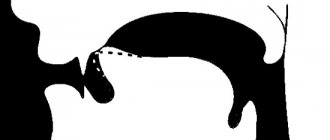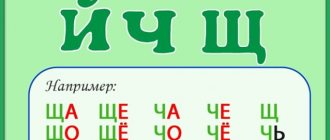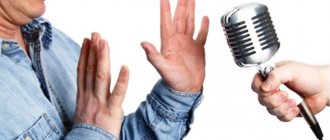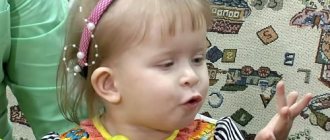Master class for parents of pupils “Playing with sounds”
Master class for parents of students
"Playing with sounds"
Prepared by a speech therapist teacher at MBDOU “Kindergarten No. 145”
Smirnova Elena Alexandrovna
Currently, teaching literacy to preschool children has acquired the status of a social order. Parents want to teach their growing children to read as early as possible. Many of them believe that it is enough to teach the child the letters, and he will begin to read and write correctly. But practice shows that knowledge of letters does not exclude serious difficulties for preschoolers in learning to read and write. Problems arise due to the fact that the basis of teaching literacy is the sound analytical-synthetic method, and not at all memorizing the alphabet.
The sound analytical-synthetic method relies on children mastering the skills of language analysis and synthesis. The method involves dividing coherent speech into sentences, sentences into words, words into syllables, syllables into sounds, and vice versa, combining sounds into syllables, syllables into words, words into sentences. This method was first described by K.D. Ushinsky in the book “Native Word”.
Our group is implementing an exemplary adapted educational program of a preschool educational institution, which is based on an exemplary adapted program of correctional and developmental work in a compensatory group of a preschool educational organization (PSE) for children with severe speech impairment (SSD) from 3 to 7 years old, author N.V. Beggar. According to this program, at each frontal/subgroup complex speech therapy lesson, tasks are solved to develop and improve the skills of sound analysis and synthesis.
Today we will learn how to use the analytical-synthetic method.
Look at the picture and listen to the short story.
"Winter came. The children went for a walk in the park. Dasha and Vanya were riding down the slide. Kolya learned to ski. The little puppy Sharik happily ran after the guys. Everyone was happy about the snowy winter days.”
Our method involves dividing coherent speech into...? (offers)
Name any sentence from this story. (answers from parents of students)
Let's divide the proposal into...? (words)
Now let’s lay out in symbols what we got. Where the long green stripe is sentences, and the yellow rectangles are words (The diagram is approximate. Parents of students lay out the diagram of the sentence that they themselves have identified from the text)
How many words are there in a sentence? What is the first/second/last word?
I propose to continue working with the last word. We need to divide it into...? (syllables are brown rectangles)
How many syllables are in this word? What is the first/last syllable?
What do you think we should do now? (answers from parents of students)
Right! Divide syllables into sounds! You can use a cheat sheet.
How many sounds are there in this word? What is the first/last sound? How many consonants/vowels are there in a word? Why did you (when addressing a specific parent) use the green symbol?
Well done! Did a great job!
Now let's get up, warm up and test this method in reverse order!
(I invite parents to stand in a circle)
I will throw you a ball and name the sounds, you return the ball to me and name the syllables from these sounds. (I abruptly pronounce 2/3 of the sound and throw the ball to my parents)
Now I give you syllables, and you give me...? (words)
Together we will form words from...? (suggestions) Let's try it!
- Murka, cat, kittens, ours.
- Squeak, kittens.
- We gave them milk.
- We ate, kittens, fell asleep, then.
- Fluff, we called the kittens, Murzik, and.
You and I have got some great suggestions from which you can make a story.
(Parents of pupils make up a story from sentences based on the picture)
Well done!
Today we played with sounds, performing sound analysis and word synthesis. This is the first step to teaching children to read and write! A child will begin to read only after he learns to combine speech sounds into syllables and words. To read a word means to synthesize combinations of individual letters that reflect the order of sounds in the word, so that they form a real, “living” word.
In my work with children, I use a variety of games with sounds, you can find them on the website govorusha.info
, as well as at the information stand in the locker room of the group room.
I invite parents to fill out the form.
| 1 | Rate the master class using a 10-point system, where 10 is the highest score, 1 is the lowest. |
| 2 | How accessible the material being studied was presented. 10 points – accessible and understandable, 1 – did not understand the topic of the master class. |
| 3 | What new did you learn during the master class? |
| 4 | Was the information provided useful to you? |
| 5 | What master classes would you like to attend or conduct yourself? |
Literary and Internet sources:
- Nishcheva N.V. An approximate adapted program of correctional and developmental work in a compensatory group of a preschool educational institution for children with severe speech impairment (SSD) from 3 to 7 years.
- Nishcheva N.V. Teaching literacy to preschool children.
- https://logoportal.ru/zvukovoy-analiz-i-sintez/.html
- https://logoped18.ru/logopedist/razvitiye-zvukobukvennogo-analiza-i-sinteza-v-protsesse-zanyatiy-logopeda.php
Master class for parents of the speech therapy group “Speech therapy games with mom”
Goal : assisting parents in organizing and conducting speech therapy games at home in non-traditional ways.
Tasks:
- to enhance parents’ knowledge about the importance of speech therapy games at home;
- to form an idea of the variety of speech therapy games and their proper organization at home;
- teach application;
- to develop the skills of conscious, adequate and effective assistance to children;
- expand the degree of involvement of parents in the implementation of individual correctional programs for working with children.
Speech sounds are formed as a result of a complex set of movements of the articulatory organs. We correctly pronounce various sounds, both in isolation and in the speech stream, thanks to strength, good mobility and differentiated work of the organs of the articulatory apparatus. Thus, producing speech sounds is a complex motor skill.
Already from infancy, the child makes a lot of diverse articulatory and facial movements with the tongue, lips, jaw, accompanying these movements with diffuse sounds (mumbling, babbling). Such movements are the first stage in the development of a child’s speech; they play the role of gymnastics of the speech organs in natural conditions of life. The accuracy, strength and differentiation of these movements develop in the child gradually. For clear articulation, strong, elastic and mobile speech organs are needed - tongue, lips, palate. Articulation is associated with the work of numerous muscles, including: chewing, swallowing, and facial muscles. The process of voice formation occurs with the participation of the respiratory organs (larynx, trachea, bronchi, lungs, diaphragm, intercostal muscles). Thus, when talking about special speech therapy gymnastics, one should keep in mind exercises of numerous organs and muscles of the face, oral cavity, shoulder girdle, and chest.
Articulatory gymnastics is the basis for the formation of speech sounds - phonemes and the correction of sound pronunciation disorders of any origin; it includes exercises for training the mobility of the organs of the articulatory apparatus, practicing certain positions of the lips, tongue, soft palate, necessary for the correct pronunciation of both all sounds and each sound of a particular group.
The goal of articulatory gymnastics is to develop full-fledged movements and certain positions of the organs of the articulatory apparatus necessary for the correct pronunciation of sounds.
Recommendations for performing articulatory gymnastics exercises
- Articulation gymnastics must be performed daily so that the skills developed in children are consolidated. It is better to perform the exercises 2 times a day, morning and evening, for 3-5 minutes. Children should not be offered more than 2-3 exercises at a time.
- Each exercise is performed 5-7 times.
- Static exercises are performed for 10-15 seconds (holding an articulatory pose in one position).
- Articulation gymnastics is performed while sitting, since in this position the child has a straight back, the body is not tense, and the arms and legs are in a calm position.
- The child must clearly see the adult’s face, as well as his own face, in order to independently control the correctness of the exercises. Therefore, a child and an adult can be in front of a wall mirror during articulation gymnastics; the child can also use a small hand mirror (approximately 9x12 cm), but then the adult must be opposite the child, facing him.
Organizing articulation gymnastics at home
- Before you start doing articulation exercises, you must find out how your child navigates in space: can he show what is on the right, left, in front, behind, above, below; whether he distinguishes between right and left hands. Without this, performing articulatory gymnastics is impossible or extremely difficult for the child.
- Talk about the upcoming exercise using game techniques.
- Demonstrate the correct execution of the exercise.
- Invite your child to repeat the exercise and monitor its completion.
- Monitor the quality of the movements performed by the child: accuracy of movement, smoothness, pace of execution, stability, transition from one movement to another.
Speech therapist : And now I suggest you do articulation exercises yourself. Place a mirror in front of you. Now you can get acquainted with the organs of articulation the way your children do.
The speech therapist reads a poem, parents examine their organs of articulation and perform actions based on the text.
Game “Fairytale-pointer” Krupenchuk O.I. Vorobyova T.A.
You're not tired yet. Show me, my hand: This is the right cheek, This is the left cheek. You are strong, not weak, Hello, upper lip, Hello, lower lip, I love you no less! The lips have one feature - a smile is locked in them: To the right is the right corner of the mouth, To the left is the left corner of the mouth. We pull the chin down so that the jaw drops. There, I’m not used to walks. My tongue hides timidly. The palate instead of the ceiling is in the mouth of the tongue. And when the mouth opened, the tongue went forward. Interesting picture: There is a tip, there is a back, There are side edges - I know everything about the mouth!
L: Each of you has been given descriptions of articulation exercises that you will perform with your child at home. Now we will try to implement them.
The speech therapist talks about the procedure for performing the articulation exercise and demonstrates the correct execution on the slide. (Parents perform the exercises “Smile”, “Pipe”, “Rolling a ball”, “Needle”, “Bunny looks out the window”, “Cup”, “Tongue on a walk”, “The steamer is humming”, “Painter”, “Painting the ceiling” "", "Sail", "Turkey", "Horse", "Mushroom", "Accordion", "Biting the tip of the tongue", "Woodpecker", "Drive away the mosquito", "Paint the top fence", "Smile-tube-square" , “Duck beak”, “Roll out the dough”, “Groovet”, “Paint the lower fence”, “Biting the side edges of the tongue”, “Spatula”, “Slide”, “Coil”).
Speech therapist : As you may have noticed, we only spent a few minutes doing these exercises. Performing articulatory gymnastics will not cause you much difficulty, but will bring great benefits to your child and will allow you to monitor his progress. Parents often complain that children do not want to do articulation exercises while sitting in front of a mirror. I want to introduce you to various playful ways to strengthen articulatory motor skills that you can use at home.
The speech therapist talks about the procedure for performing articulation exercises with non-traditional devices and demonstrates correct execution. Parents repeat the exercises independently in front of mirrors.
Exercises with a ball. The author of this technique is S.V. Konovalova
(ball diameter 2 - 3 cm, rope length 60 cm, rope threaded through a through hole in the ball and tied in a knot)
- Move the ball along the rope stretched horizontally on the fingers of both hands with your tongue to the right and left.
- Move the ball upward along a vertically stretched rope with your tongue (the ball falls down randomly).
- Push the ball up and down with your tongue, the rope is stretched horizontally.
- Spin the ball with lapel movements of the tongue.
- The tongue is “Cup”, the goal is to catch the ball in the “Cup”.
- Catching the ball with your lips, pushing it out with force, “spitting” it out.
- Catch the ball with your lips. Close your lips as much as possible and roll the ball from cheek to cheek.
- Tell tongue twisters with a ball in your mouth, holding a string with your hands.
Note : While working, the adult holds the rope in his hand. After each lesson, rinse the ball and string thoroughly with warm water and baby soap and dry with a napkin. The ball must be strictly individual.
Exercises with a spoon.
- Tongue – “Spatula”. Tap the convex part of a teaspoon on your tongue.
- Press the edge of the spoon on the relaxed tongue with pushes.
- Press the spoon tightly against the lips in front of the lips, folded into a tube, with the convex side and make circular movements clockwise and counterclockwise.
- Stretch your lips into a smile. Use the convex part of a teaspoon to make circular movements around your lips clockwise and counterclockwise.
- Take a teaspoon in your right and left hand and make light patting movements on your cheeks from bottom to top and top to bottom.
- Circular movements with teaspoons on the cheeks (from nose to ears and back).
- Patting teaspoons on the cheeks with both hands simultaneously from the corners of the mouth stretched in a smile to the temples and back.
Games with cotton balls and bottles, candles
"Air football" . Stretch your lips forward with a “tube” and blow for a long time on the ball (lying on the table in front of the child), driving it between two cubes. The options depend on your imagination. You can offer the child to blow on a pinwheel, small toys that easily roll on the table, or cotton wool (blow from the palm).
“Singing bottle” A directed air stream is well produced if you invite the child to blow into a small, clean bottle (from under the drops). When an air stream hits the bottle accurately, a peculiar humming or whistling sound is heard (“steamboat humming”). Children really like this.
Note!
- Be careful not to puff out your cheeks. To do this, you can lightly hold them with your fingers.
- You need to drive the ball in one exhale, not allowing the air stream to be intermittent.
Candle.
Buy small colorful candles and play with them. You light candles and ask the child to blow on a blue candle, then on a yellow candle, etc. You need to blow slowly, the inhalation should not be noisy, and you cannot puff out your cheeks. First, you can bring the candle closer to the child, then gradually remove it.
"Parachute"
Smile, open your mouth slightly, place the wide front edge of your tongue on your upper lip so that its side edges are pressed together and there is a small groove in the middle. Then blow gently upward onto your nose. Complication: Attach a piece of tracing paper or cotton wool (1.5 cm x 1.5 cm) to the tip of the nose and blow it off; with the right air stream, it flies upward. In order for the tracing paper to easily attach to the nose, you need to slightly moisten it (pass it along the tip of the child’s tongue).
Note!
- The lower teeth do not “pull” the tongue upward.
- Do not clench your tongue with your teeth.
- The exhalation is smooth and long. This exercise trains the exhalation necessary to pronounce hissing sounds.
“Sweet exercise” (exercises with lollipop).
L: You might be surprised, but a round sweet lollipop is an excellent speech therapy simulator. Unwrap the candy canes and let's play a little. Squeeze the lollipop with your lips and try to hold it for 5-10 seconds. Holding the lollipop with your lips, try moving the stick first from top to bottom, then from side to side. Open your mouth slightly, lips parted into a smile, make a cup, put lollipop in the cup and try to hold the lollipop with your tongue only. Raise your wide tongue to the sky, press the lollipop “fungus” to the palate. Move the lollipop along the midline of your tongue from tip to root and back 5-10 times. During the performance of articulatory gymnastics, you will see how, at first, when children perform exercises, tension in the movements of the organs of the articulatory apparatus is observed. Gradually the tension will disappear, movements will become relaxed and at the same time coordinated.
You cannot tell your child that he is doing the exercise incorrectly - this can lead to a refusal to perform the movement. It’s better to show the child his achievements (“You see, your tongue has already learned to be wide”), encourage (“It’s okay, your tongue will definitely learn to rise up”). In the process of performing gymnastics, it is important to remember to create a positive emotional mood in the child; for this, you can show your imagination and turn articulatory gymnastics into a fairy tale. You can use special thematic literature, which will be an excellent help in your work and will make your classes more interesting and fun.
L: We have already talked about the benefits of joint articulation and finger gymnastics , here are some examples:
"BALL"
Puff out your cheeks. Blow off your cheeks.
All fingers of both hands are in a “pinch” and their tips touch. In this position, we blow on them, while the fingers take the shape of a ball. The air “comes out” and the fingers return to their original position.
"MOUSE"
Lips in a smile. Open your mouth slightly. Say “ah...” and bite the wide tip of your tongue (catch the mouse by the tail).
The middle and ring fingers rest on the thumb. The index and little fingers are bent into arches and pressed against the middle and ring fingers.
"CAT"
Lips in a smile. The mouth is open, the tip of the tongue rests on the lower teeth. On the count of 1, arch your tongue, resting the tip on your lower teeth.
The middle and ring fingers rest on the thumb. The index and little fingers are bent into arches and pressed against the middle and ring fingers.
"HORSE"
Lips in a smile. Open your mouth slightly. Click your tongue (like horses click).
The right palm is on the edge away from you. Thumbs up. The left palm is placed on top of it at an angle, forming a mane with the fingers. Thumbs up. The two thumbs form the ears.
"THE BUNNY AND THE DRUM"
Smile. Open your mouth. Using the tip of your tongue, tap behind your upper teeth “de-de-de.”
Fingers in fist. The index and middle fingers are up, they are pressed. We tap the thumb with the ring and little fingers.
"ELEPHANT"
Form an elephant's trunk by stretching your lips forward with a straw, and draw some water while smacking your lips slightly.
Palm towards yourself. The middle finger is in. On one side it is sandwiched by the little and ring fingers, and on the other by the index and thumb. Move your middle finger. Swing with the whole brush.
During the period of consolidation of isolated sounds, you can pronounce them with finger exercises, for example:
"GOOSE"
The forearm is vertical. Palm at right angle. The index finger rests on the thumb. All fingers are pressed against each other. "Sh - Sh - Sh"
"BUG"
Fingers in fist. The index and little fingers are spread apart, the child moves them. "F - F - F"
"WASPS"
Extend your middle finger, hold it between your index and ring fingers and rotate it in different directions. "Z - Z - Z"
"DOG"
Right palm on the rib, towards yourself. Thumbs up. The index, middle and ring fingers are together. The little finger alternately lowers and rises. "R - R - R"
Literature:
- “Tra-la-la for the tongue. Articulation gymnastics. For children 2-4 years old" Publishing house: Karapuz, 2003.
- Kostygina V. “Boo-Boo-Boo.” Articulation gymnastics (2-4 years) Publisher: Karapuz, 2007.
- Pozhilenko E.A. “Articulation gymnastics: guidelines for the development of motor skills, breathing and voice in children...” Publisher: Karo, 2006.
Lyubeznova Olesya Valerievna MBDOU Kindergarten No. 19 “Forest Fairy Tale” Balashikha, Moscow region.
Master class for parents Topic: “Homework as a means of overcoming speech disorders”
5. Create positive motivation for doing homework and its long-term perspective.
6. Encourage your child for homework done well.
7. Praise your child, rejoice at his results associated with a positive mark.
8. Help your child with homework only if he needs it.
9. Don’t try to do the homework for your child; it’s better for him not to do his homework at all than for you to do it.
10. You should not give more than 2-5 exercises in one lesson (depending on the child’s individual capabilities); you should not rush the child while completing tasks.
11. The duration of one lesson should be no more than 15-20 minutes.
12. Consult a speech therapist if you see that your child is having difficulty preparing homework.
We remind you once again: take your time, do not try to teach your child everything at once, master each task gradually, only when the previous one has been mastered. Don’t forget to praise your child not only for success, but also for effort.
2. Master class.
The leading activity in preschool age is play.
Today we will return to childhood - we will become children again and play.
Articulatory gymnastics plays a very important role when working on sound production.
Articulation gymnastics
is a set of specially selected exercises for the organs of articulation aimed at correcting pronunciation deficiencies.
The purpose of articulation gymnastics
- development of the correct movements of the articulatory organs necessary for the correct pronunciation of sounds, as well as strengthening the muscles of the face, tongue, lips, soft palate.
Recommendations for performing articulation gymnastics
— Articulation gymnastics must be done daily so that the skills developed in children are consolidated. It is better to perform the exercises 3-4 times a day for 3-5 minutes.
— Each exercise is performed 5-7 times. — Static exercises are performed for 10-15 seconds (holding an articulatory pose in one position). — When selecting exercises for articulatory gymnastics, you must follow a certain sequence, going from simple exercises to more complex ones. It is better to spend them emotionally, in a playful way. — Of the two or three exercises performed, only one can be new; the second and third are given for repetition and consolidation. If a child does not perform an exercise well enough, new exercises should not be introduced; it is better to practice old material. To consolidate it, you can come up with new gaming techniques. — Articulation gymnastics is performed while sitting. In this position, the child has a straight back, the body is not tense, the arms and legs are in a calm position. — The child must clearly see the adult’s face, as well as his own face, in order to independently control the correctness of the exercises. Therefore, a child and an adult should be in front of a wall mirror during articulation gymnastics. You can use a small mirror on a stand, in which case the adult should be opposite the child, facing him. — It’s better to start gymnastics with lip exercises. During the training, parents repeat basic articulation exercises after the speech therapist, preparing the child’s speech apparatus to produce impaired sounds and developing his mobility.
MAGAZINE Preschooler.RF
Master class meeting for parents in a senior speech therapy group on the topic: “Useful gymnastics”The calling of a speech therapist is to improve the quality of communication. In speech therapy work on correcting sound pronunciation, an important stage is articulatory gymnastics (AG). For effective sound production, it is necessary to perform AG daily, including reinforcing the exercises at home. In the 2015-2016 academic year, a senior speech therapy group for children with ODD was recruited again. At the beginning of the year, a survey of parents was conducted and it was revealed that 40% do not consider performing AG a mandatory task, some find it difficult to perform the exercises and it is not clear how to find out whether the child is performing the exercise correctly. Thus, it was decided that it was necessary to hold a parent meeting on the topic: “Articulation gymnastics” .
Goals:
- Develop the ability to correctly perform articulatory gymnastics (AG).
- Develop motivation to perform hypertension with the child.
- Duration of the meeting: 45 minutes. Number of parents: 16 people.
Structure of the meeting: 1. Welcome. Task "Chamomile" , which allows you to quickly split into two teams or pairs. And also motivating questions. 2. Two teams for a time (three minutes), each on their own Whatman paper, write AG exercises (competing in quantity and accuracy): name + instructions on how to perform (can be a drawing or diagrammatically). 3. The winning team is declared an assistant to the speech therapist and receives the role of a parent in the pairs game “Articulation gymnastics - at home” . The parents of the second team get the role of the child. Each of the helpers' parents receives two reminders and a mirror to share with their playing partner. 4. Questions from parents. 5. Recommendations of a speech therapist for conducting hypertension.
Questions on chamomile:
1. Do our children need articulation gymnastics?
- What is articulation gymnastics?
- What muscles are articulatory gymnastics used for?
- How often should you do articulation exercises?
- What will you need to perform articulatory gymnastics?
- Will articulation gymnastics be more effective under parental supervision?
- How many approaches of one AH exercise should be performed?
- What difficulties may a child encounter when performing AH?
- What to do if a child’s tongue turns blue during AG?
- When is the best time to do AG?
- Does your child need beautiful, clear, intelligible speech?
- In what areas of life and professions is clear and beautiful speech important?
- Does a person with slurred speech seem quite happy to you?
- Do you want your child to be sociable?
- Do you find it difficult to pronounce any word yourself?
- Will hypertension be useful for an adult?
Recommendations
Based on the division of system-vector psychology by Yuri Burlan into vectors,
An active, restless child will calm down during exercises if he is given a parallel hand massage, stroking, fingering tactile elements with his hands, self-massage of the hands with needle balls, etc.
Active, not liking an edifying tone (a leader by nature) - will be happy to carry out tasks in which there is a playful moment of an important mission in which the child would feel like a leader and responsibility.
A slow child will cope better with tasks requiring attention and accuracy; we teach him self-control. And the reward for each completed exercise is a puzzle piece or a cube to eventually put together a picture or figure.
| Next > |









